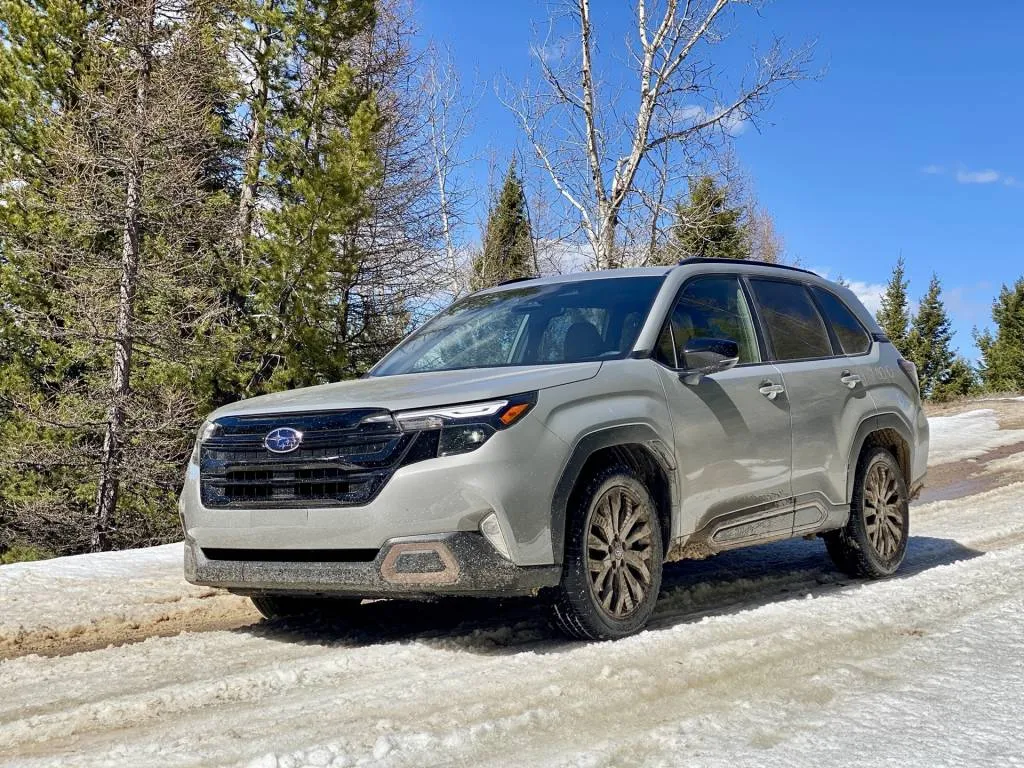Compact crossover SUVs have become increasingly popular in the U.S., with the 2025 Toyota RAV4 leading the pack as the bestselling model in its segment. The RAV4 offers a range of choices, including gas, hybrid, and plug-in hybrid options, making it a versatile option for all types of drivers.
On the other hand, the 2025 Subaru Forester prioritizes safety and all-wheel-drive capability. While it may not have the rugged appearance of some of its competitors, the Forester is more off-road capable and now boasts a more refined cabin. With standard all-wheel drive and top safety ratings, the Forester excels in its own right.
Toyota and Subaru, who collaborate on other vehicles as well, seem to benchmark each other in this competitive segment. Subaru prices the Forester within $300 of the RAV4, and Toyota has raised the suspension on its off-road models to match Subaru’s 8.7 inches of ground clearance.
Despite tough competition from other models like the Honda CR-V, Hyundai Tucson, and Nissan Rogue, the Toyota RAV4 and Subaru Forester stand out with their unique features and capabilities. Whether you prioritize fuel efficiency, off-road capability, or safety, both models offer something for everyone.
When it comes to pricing and features, the base Forester starts at $31,090, while the base RAV4 LE is priced at $30,245. The RAV4 Hybrid XLE and Forester Sport are considered the best picks in their respective lineups, offering a balance of features and affordability.
In terms of performance, the RAV4 Prime shines with its plug-in hybrid technology, while the Forester focuses on capability and comfort. The Forester’s full-time all-wheel-drive system and off-road traction control make it a reliable choice for adventurous drivers, while the RAV4 prioritizes fuel efficiency and versatility.
Overall, both the Toyota RAV4 and Subaru Forester offer unique strengths and features that cater to different types of drivers. Whether you prioritize safety, off-road capability, or fuel efficiency, both models have something to offer in the competitive compact crossover SUV segment.
The Subaru Forester’s excellent outward visibility is a standout feature, thanks to its large windows and slim roof pillars. This makes it easier for drivers to see their surroundings and avoid potential hazards on the road.
Advantage: The Subaru Forester’s superior outward visibility and advanced driver-assist features.

2025 Subaru Forester
Conclusion
In the battle between the Toyota RAV4 and the Subaru Forester, both vehicles offer unique advantages that cater to different needs. The Toyota RAV4 stands out for its impressive fuel efficiency, powerful hybrid and plug-in hybrid options, and solid safety ratings. On the other hand, the Subaru Forester excels in providing a spacious interior, excellent outward visibility, and advanced driver-assist features.
Ultimately, the choice between the two comes down to personal preference and priorities. Whether you prioritize fuel efficiency and power or interior space and safety features, both the Toyota RAV4 and the Subaru Forester are capable, adventurous, and calm options in the competitive SUV market.
The Subaru Forester and Toyota RAV4 are two popular choices in the compact crossover segment, each offering its own set of advantages. While both vehicles receive top crash-test scores, the Forester stands out for its wide open views thanks to its slim roof pillars and high driver’s seat. This allows for unparalleled visibility out of the front windshield and rear quarters, making it a standout in its class.
In terms of styling, the RAV4 boasts an angular and adventurous design with pronounced fender flares and an angled roofline that exudes a sense of adventure. The cabin features a simple horizontal layout with a tiered dash and tight center stack, along with upscale touches like an available 12.3-inch touchscreen and synthetic leather upholstery. On the other hand, the Forester takes a more practical approach with its boxy SUV ends and wide open greenhouse, providing a tall profile and a bulldog front end that enhances visibility and maneuverability on challenging trails.
When it comes to performance, the RAV4 Hybrid or Prime models offer great acceleration and fuel economy, giving it an edge over the Forester. However, the Forester is expected to receive a perfect 10 safety rating, which will boost its overall TCC Rating to a 6.8 once tested by the NHTSA. Ultimately, the choice between the two comes down to personal preference and priorities.
In conclusion, both the Subaru Forester and Toyota RAV4 are solid picks in the compact crossover segment. While the RAV4 may have a slight edge in terms of performance, the Forester’s excellent visibility and safety ratings make it a compelling option for those who prioritize these factors. Whether you prefer the adventurous styling of the RAV4 or the practical design of the Forester, you can’t go wrong with either choice. Every year, millions of people around the world come together to celebrate Earth Day on April 22nd. This special day is dedicated to raising awareness about environmental issues and promoting ways to protect our planet for future generations. From planting trees to cleaning up beaches, Earth Day is a time for individuals and communities to take action and make a difference.
One of the main goals of Earth Day is to bring attention to the importance of sustainability and conservation. With climate change and pollution threatening our planet, it is more crucial than ever to make changes in our daily lives to reduce our impact on the environment. This can include using reusable water bottles, recycling and composting, reducing energy consumption, and supporting eco-friendly businesses.
Many Earth Day events focus on education and outreach, providing information and resources for people to learn more about environmental issues and how they can get involved. Workshops, seminars, and panel discussions are often held to discuss topics such as renewable energy, waste reduction, and conservation efforts. These events can inspire individuals to take action and make positive changes in their own lives.
Earth Day is also a time for communities to come together and participate in hands-on activities that benefit the environment. Tree planting initiatives, beach clean-ups, and recycling drives are just a few examples of the activities that take place on Earth Day. These events not only help to improve the local environment, but they also foster a sense of community and camaraderie among participants.
In addition to community events, many businesses and organizations also take part in Earth Day by launching sustainability initiatives or hosting green-themed events. From offering discounts on eco-friendly products to organizing volunteer opportunities for employees, companies can use Earth Day as a platform to showcase their commitment to environmental stewardship.
Overall, Earth Day serves as a reminder of the importance of protecting our planet and the role that each of us plays in ensuring a sustainable future. By coming together on April 22nd and throughout the year, we can make a real difference in the fight against climate change and environmental degradation. So let’s all do our part to make every day Earth Day!







